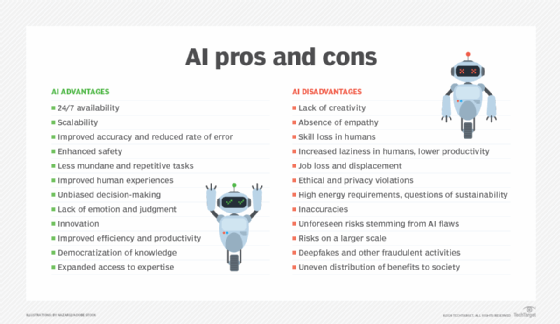
5 steps to design an effective AI pilot project
Getting employee feedback on new technology can help mitigate risks before deployment. Learn key steps to follow when implementing an AI pilot project.
Many IT leaders are currently under pressure to determine how best to incorporate AI into company processes. An AI pilot project can give insight into potential uses for the technology and how to deploy the new tech.
Adding AI to business processes brings up various potential issues, including incorporating the technology into existing infrastructure, carrying out the proper training and ensuring all required legal processes are followed. The best way to address these concerns is to implement an AI pilot project before rolling out the new tech to all employees.
Learn about the team members to add to an AI pilot project and steps to follow for the pilot.
5 steps to follow for an AI pilot project
Implementing AI is vastly different than implementing past technology. In contrast to an application controlling the predefined inputs and outputs, AI might give employees different outputs to employees' questions, depending on their requests. In addition, AI applications that have been trained externally might give employees incorrect answers because the AI has not been trained on company data.
A step-by-step approach can help IT leaders navigate the complexities of AI implementation.
1. Establish project goals
Before beginning an AI pilot project, the project sponsor should develop the project's goals with the help of key stakeholders, such as department leaders and technical staff.
The goals should include a projected go-live date, KPIs for the project and milestones that the project must hit for go-live to proceed.
The project sponsor can share the goals with other team members as the new members join the project and can also consider sharing the goals more widely if other employees are curious about the project and the topic of AI in the workplace.
2. Solicit legal advice
The company's legal team should weigh in on certain topics before the AI pilot project begins. For example, the IT employees configuring and training the application must be aware prior to the start of the project if certain company data is off-limits because of legal reasons.
In addition, technical IT staff should perform testing to confirm that users cannot access certain data through the AI application. For example, technical IT staff should check whether users can access confidential employee data through the AI tool.
3. Calculate potential ROI
As part of the project initiation phase, the executive sponsor should consider the ROI from implementing AI. One project KPI could be particular ROI.
The team can calculate potential ROI from the AI tool based on research and input from vendors. The pilot project team might need to adjust ROI as the project progresses so projected ROI is as accurate as possible.
4. Build internal buy-in
Employees often have concerns about new technology implementations, but employees at all levels might feel particularly worried about AI, including wondering whether AI will lead to job cuts and whether the model is able to access confidential information.
The project sponsor should speak with members of the C-suite about these potential employee concerns. Sharing how the company intends to use AI and explaining the guardrails that protect confidential information could help alleviate these anxieties.
5. Capture ongoing feedback
A key advantage of conducting an AI pilot project is receiving employee feedback about the AI application. For example, workers can weigh in on whether the application is providing accurate information, whether employees can access needed information, whether they are seeing data that they shouldn't be able to view and whether the tool is helping them save time, among other feedback.
Employees who are testing the technology should share feedback regularly so technical staff can provide senior leaders with status updates and have plenty of time to reconfigure the AI application if needed before go-live.

Who's who on an AI pilot project
An AI pilot project requires a cross-functional team of employees. A senior leader, such as the CIO or VP of IT, usually serves as the executive sponsor who is responsible for making the final decision on whether to move forward with the technology. The leader makes that decision after consulting with other executives and the pilot project team.
An IT project manager develops and manages the schedule, while the IT director or manager handles most questions and issues that arise during the pilot. Technical IT staff, such as an IT architect and technical support, are involved in the technology configuration and integrations. They also support employees who are part of the pilot project.
The team might also include training specialists, who teach employees about how to use the application, and the employees themselves, who are carefully selected from different departments and who test the new technology.
Eric St-Jean is an independent consultant with a particular focus on HR technology, project management and Microsoft Excel training and automation. He writes about numerous business and technology areas.







